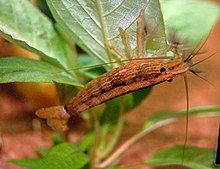Moluccan fan shrimp
| Moluccan fan shrimp | ||||||||||||
|---|---|---|---|---|---|---|---|---|---|---|---|---|

Moluccan fan shrimp ( Atyopsis moluccensis ) |
||||||||||||
| Systematics | ||||||||||||
|
||||||||||||
| Scientific name | ||||||||||||
| Atyopsis moluccensis | ||||||||||||
| ( De Haan , 1849) |
The Moluccan fan shrimp ( Atyopsis moluccensis ), also known as the Moluccan mountain stream shrimp or radar shrimp , is an Asian freshwater shrimp (Atyidae) from the genus of the fan shrimp ( Atyopsis ).
Occurrence
The species is distributed in South and Southeast Asia, from India and Sri Lanka to Thailand and the Malay Peninsula , Indonesia to New Guinea . It owes its name to the Indonesian archipelago of the Moluccas .
features
The animals are up to 8.6 cm long and are very variable in color. The basic color ranges from light to dark brown, with dark side stripes or interrupted patterns as a drawing; there are also specimens with a light line on the back. In the past, specimens from different regions were incorrectly assigned to different species. Fan shrimp do not reproduce in captivity and the classification of the color types into the common species came relatively late.
Ingestion
Like all fan shrimp Atyopsis moluccensis has long bristles on the first two pairs of striding legs, which are used to filter plankton . In the active state, they are unfolded like a fan, held in the flow and pulled out under the body, pulled together at regular intervals. The filtered out microorganisms are absorbed by the shrimp. The delicate bristle apparatus is often cleaned and tidied up.
The two pairs of fan-shaped legs are also used for locomotion and support, the bristles then being folded together to form small, tapering cones. When swimming, the legs are kept close under the body.
Way of life
The adult animals live in flowing water and prefer places with very strong currents. Young animals stay in areas with calmer water. Despite the common name Moluccan mountain stream shrimp, the species occurs only in warm waters in the lowlands and not in mountains.
Reproduction
The details of reproduction are not known. Presumably, the larvae migrate downstream and develop in sea or brackish water before switching back to fresh water. This behavior is shown by many freshwater shrimp species whose larvae depend on a minimum salt content in the first few weeks of life. They are evolutionarily derived from purely marine species, although not all lines of development have acquired the ability to reproduce in freshwater. As possible reasons for the need for salt in the first weeks of life, peculiarities in the metabolism and, above all, processes during the molting in the larval stage are discussed. Successful offspring in human care have already been reported.
Fan shrimp in the aquarium hobby
The animals - also marketed as fan hand shrimp - are often kept in aquariums . However, they make special demands on the keeping conditions and prefer strongly moving water with a high proportion of suspended matter, including algae and small animal organisms. Optimal feeding in captivity is considered difficult, especially since water that is rich in suspended matter or cloudy is often undesirable. Constantly optimal conditions can only be created in captivity by constantly adding small amounts of food, because the composition of aquarium water has to be regulated in a closed circuit with filters, which also continuously remove the food of the shrimp from the water. Captured fan shrimp sometimes tend to puddle in the soil or ingest sessile food organisms, although it is not known to what extent they show this behavior in the wild.
Web links
- Atyopsis moluccensis inthe IUCN 2013 Red List of Threatened Species . Posted by: De Grave, S., Klotz, W. & Page, T., 2011. Retrieved January 20, 2014.
- Description in the species database of wirbellose.de
literature
- Andreas Karge, Werner Klotz: Freshwater prawns from all over the world . Dähne Verlag, Ettlingen 2007, ISBN 978-3935175-39-5 .
